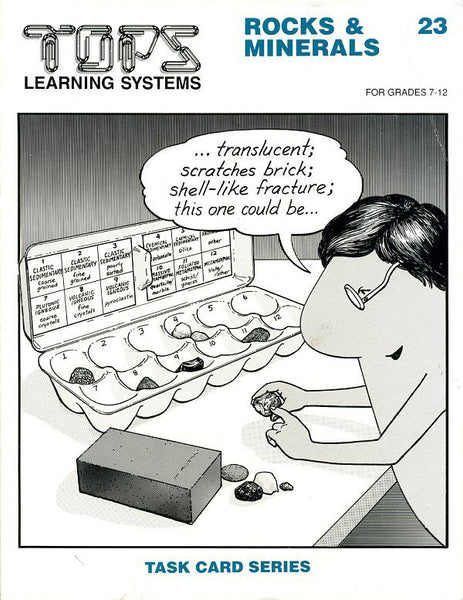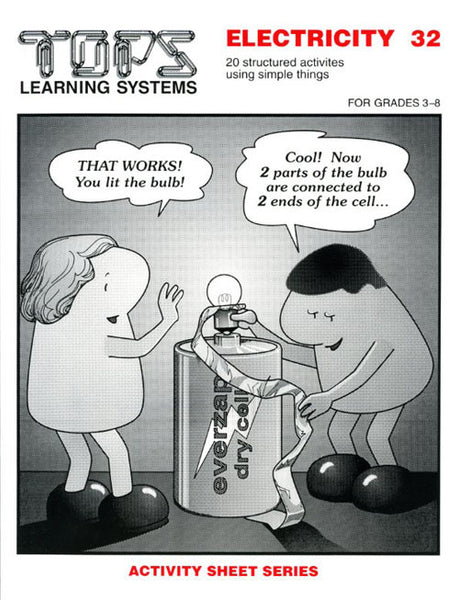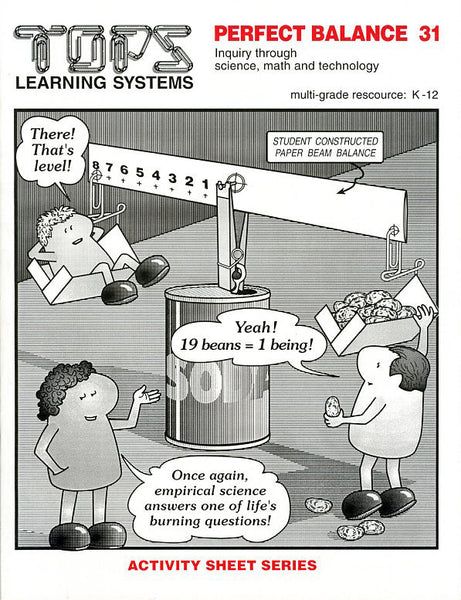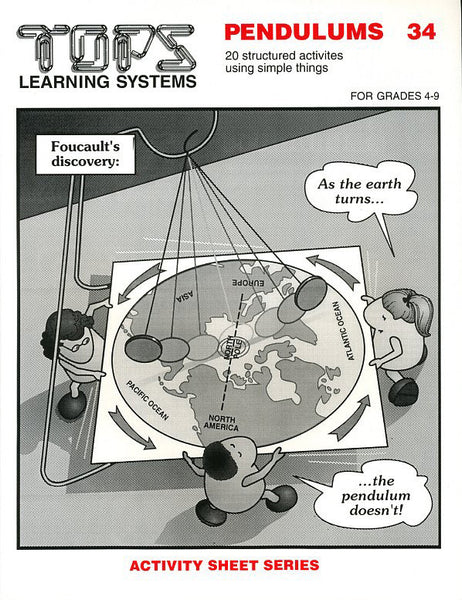#23 Rocks and Minerals (grades 6-12)
Regular price $23.95
Soft-bound, 88 page book, 36 reproducible task cards, full teaching notes.
No exotic or expensive specimens needed, and you can order support kits directly through TOPS. Examine, test and classify rock samples from your own back yard. Unearth igneous, sedimentary, metamorphic rock, then subdivide by geological formations. An egg carton organizes everything into a unique collection of personal discovery and learning. Many labs are accessible to younger kids, too.
Click here for a complete list of materials and convenient shopping.
notebook paper, straight edges), sand with flecks of mica, pie tins, hand lenses, sugar, microscope slides, candle, granite and basalt, about golf ball size, small glass jars or beakers, eyedroppers, table salt, pennies, paper clips, bricks, chalk, masking tape, test tubes, 5% hydrochloric acid, margarine lids, sea shells, pliers, large coffee can or equivalent safety goggles (or twice this many plastic produce bags), scissors, egg cartons, oil-based clay, gram balances, paper towels, 100 mL graduated cylinders, pepper, calculators,marbles film canisters, wash tubs (or buckets), freezer, Epsom salt, stirring rods dictionaries- Lesson 1: To appreciate that the earth's crust is made almost entirely from eight basic elements. To graph these elements on a bar graph.
- Lesson 2: To sort grains of sand by shape, opacity and color. To identify three common minerals in sand.
- Lesson 3: To recognize that one mineral may assume different solid forms. To account for the great diversity of rocks in the earth's crust.
- Lesson 4: To observe that coarse crystals form more slowly than fine crystals. To deduce the origin of granite and basalt based on the size of their crystals.
- Lesson 5: To interpret the hardness or softness of objects by scratching one against the other. To construct a scale of relative hardness for common objects.
- Lesson 6: To interpret the hardness or softness of objects by streaking them across brick.
- Lesson 7: To mechanically erode pieces of granite by rubbing them together. To understand how this happens in nature, changing the appearance of rock and producing soil.
- Lesson 8: To study how wind and water sort rock clasts by size and deposit them into graded beds.
- Lesson 9: To mechanically generate a new sedimentary rock from preexisting igneous rock.
- Lesson 10: To dissolve a piece of chalk in weak acid and observe the resulting erosion patterns. To contrast chemical weathering with mechanical weathering.
- Lesson 11: To trace the path of calcium carbonate as it travels from limestone to water, to living organisms, to shelled remains, and finally recycles back to chalk and limestone.
- Lesson 12: To examine two common cementing agents found in sedimentary rock. To consider the various kinds of rock derived from these cements.
- Lesson 13: To crack open rocks and save assorted pieces for later identification and display in a rock collection.
- Lesson 14: To compare the relative hardness of collected rock samples. To tag them for later identification and analysis.
- Lesson 15: To distinguish between rocks with random and ordered textural patterns. To use these textural clues to identify metamorphic rock.
- Lesson 16: To begin sorting rocks into 12 basic egg-carton categories on a tentative basis, according to each rock's geological origin.
- Lesson 17: To introduce a six-part write-up procedure for reporting about rocks that students identify over the next four task card activities.
- Lesson 18: To identify and describe clastic sedimentary rocks that belong to egg-cup categories 1-3.
- Lesson 19: To identify and describe chemical sedimentary rocks that belong to egg-cup categories 4-6.
- Lesson 20: To identify and describe igneous rocks that belong to egg-cup categories 7-9.
- Lesson 21: To identify and describe chemical metamorphic rocks that belong to egg-cup categories 10-12.
- Lesson 22: To understand how igneous, sedimentary and metamorphic rocks continuously change form, creating one grand cycle of change. To see the bigger picture.
- Lesson 23: To represent the relative abundance of common rocks as a bar graph. To develop an overview.
- Lesson 24: To compare the permeability of chalk and clay. To evaluate which types of collected rocks are the most water permeable.
- Lesson 25: To determine the density of clay. To discover that each substance has a unique density, regardless of the volume measured.
- Lesson 26: To compare the densities of granite and basalt. To relate density to the position of rocks within the earth's crust.
- Lesson 27: To account for differences in density between crystallized silica and fused silica.
- Lesson 28: To compute the density of water. To use this special result to develop the notion of specific gravity.
- Lesson 29: To understand how freezing water contributes to the mechanical erosion of rock.
- Lesson 30: To study how the concentration of salt affects the size of crystals that precipitate from solution.
- Lesson 31: To explain how veins of pegmatite form in plutons of granite.
- Lesson 32: To soak a paper towel in Epsom salt and speculate how this might "petrify" the paper.
- Lesson 33: To model how silicates petrify wood and how carbonates form stalactites and stalagmites in caves.
- Lesson 34: To model a silica tetrahedron. To demonstrate how this negative unit combines with positive ions to form neutral minerals.
- Lesson 35: To model how silicate tetrahedra join together in different ways, producing a variety of mineral forms.
- Lesson 36: To trace the path of a silica tetrahedron through the rock cycle.
National Science Education Standards (NRC 1996)
TEACHING Standards
These 36 task cards promote excellence in science teaching by these NSES criteria:
Teachers of science...
A: ...plan an inquiry-based science program. (p. 30)
B: ...guide and facilitate learning. (p. 32)
C: ...engage in ongoing assessment of their teaching and of student learning. (p. 37)
D: ...design and manage learning environments that provide students with the time, space, and resources needed for learning science. (p. 43)
CONTENT Standards
These 36 task cards contain fundamental content as defined by these NSES guidelines (p. 109).
• Represent a central event or phenomenon in the natural world.
• Represent a central scientific idea and organizing principle.
• Have rich explanatory power.
• Guide fruitful investigations.
• Apply to situations and contexts common to everyday experiences.
• Can be linked to meaningful learning experiences.
• Are developmentally appropriate for students at the grade level specified.
Unifying Concepts and Processes
NSES Framework: Systems, order, and organization • Evidence, models and explanation • Constancy, change, and measurement • Evolution and equilibrium • Form and function
Core Concepts/Processes: Identify igneous, sedimentary and metamorphic rocks. Subdivide them by geological formation.
Science as Inquiry (content standard A)
NSES Framework: Identify questions that can be answered through scientific investigations. • Design and conduct a scientific investigation. • Use appropriate tools and techniques to gather, analyze, and interpret data. • Develop descriptions, explanations, predictions, and models using evidence. • Think critically and logically to connect evidence and explanations. • Recognize and analyze alternative explanations and predictions. • Communicate scientific procedures and explanations. • Use mathematics in all aspects of scientific inquiry.
Core Inquiries: Examine, test and classify rock samples.
Physical Science (content standard B)
NSES Framework: Properties and changes of properties in matter
Core Content: Permeability • Density • Specific gravity
Earth and Space Science (content standard D)
NSES Framework: Properties of earth materials • Changes in earth and sky • Structure of the earth system • Energy in the earth system • Geochemical cycles
Core Content: Rock classification and formation • Mechanical and chemical weathering • Transport and sorting • Hardness • Chemical composition • Rock cycles






